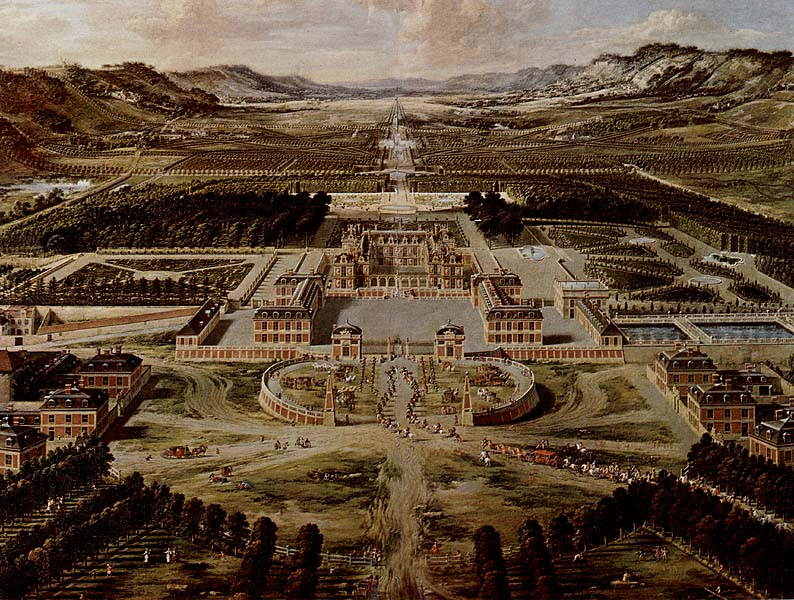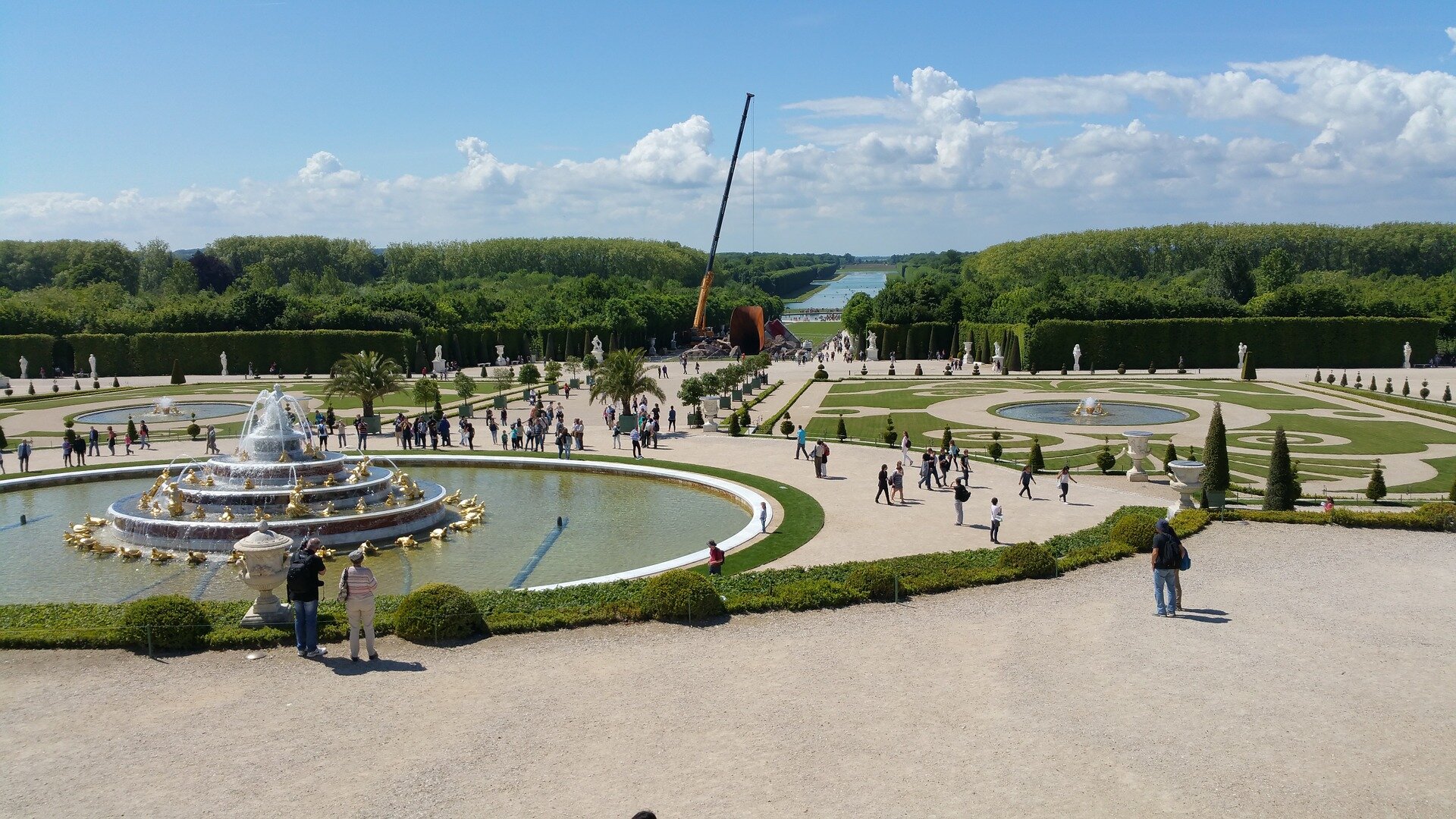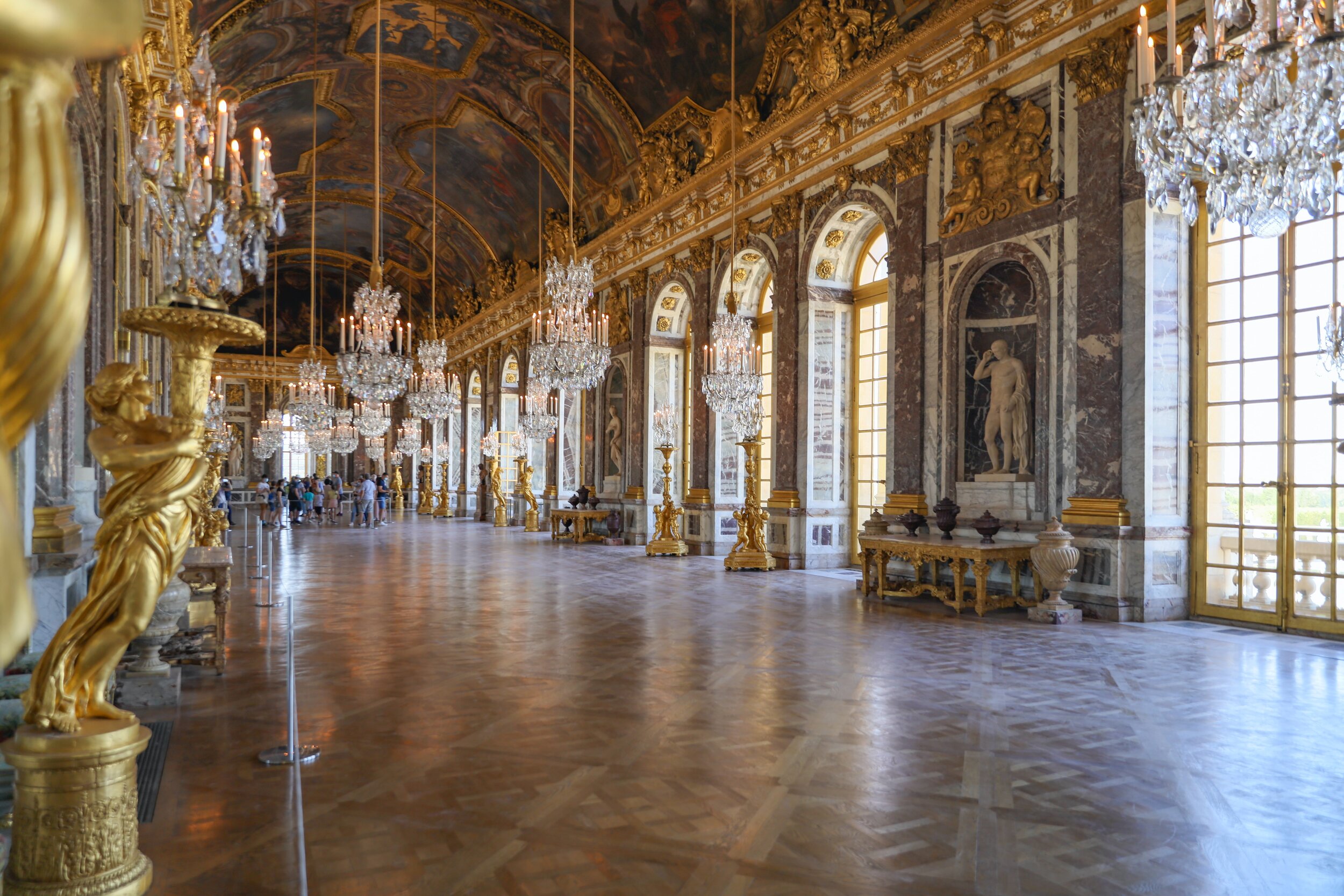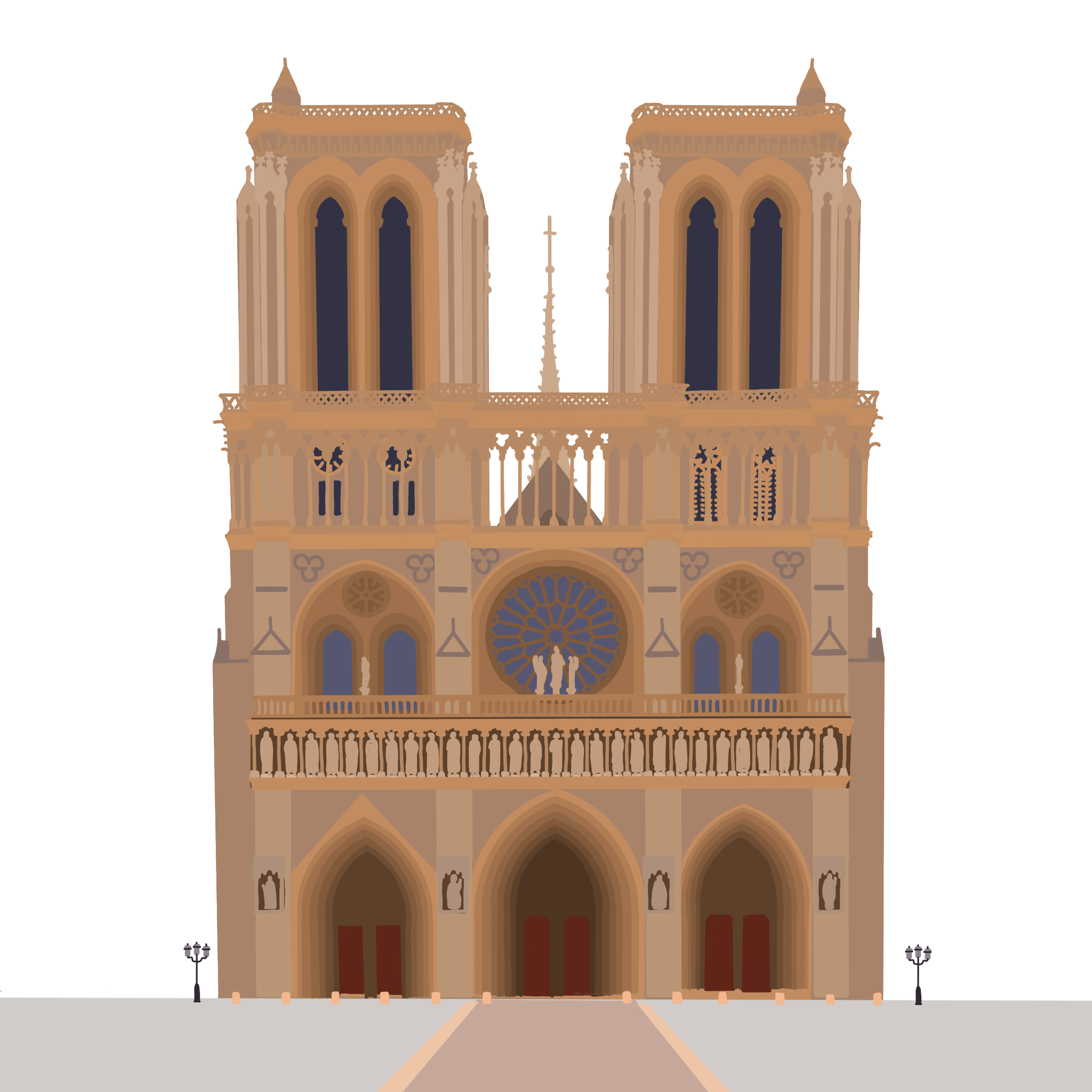Palace of Versailles
The Palace of Versailles is a major part of French history
It has been the home of some of the most influential French monarchs and epitomises the country’s history and identity. Located in a town of the same name, we’ll discover the exquisite extravagance of one of the most popular chateaux in the world.
Before the Palace
The residence that would one day grow up to be a big and strong palace, was originally a small hunting lodge, used by Henri IV and his family. His son, Louis XIII liked the place so much that in 1624, he constructed a chateau in the lodges place. This chateau still stands within the current palace. When Louis XIV wanted to expand the chateau into something grander still, he pretty much built around his predecessors building.
Louis XIV also wished to create a whole new town, so the original village of Versailles was destroyed in 1673. If you visit the palace today, you will find a bustling urban landscape with the palace at its centre. It was throughout Louis XIV’s reign that the chateau was transformed into the extravagant complex, surrounded by stylised French gardens that we see today. With every detail of the palace and its gardens intended to glorify the King and his divine right to rule.
The Palace and the French Monarchy
In 1682, the Palace was declared the official royal residence for the French monarchy when Louis XIV installed the court and government at Versailles. The successive Kings of France continued to embellish the Palace right up to when the French Revolution cut down the French monarchy (the first time).
Throughout its life, the Palace of Versailles was mainly used by three monarchs, Louis XIV, Louis XV and probably most famous of all, Louis XVI. Each left their own unique mark on the palace. One more so than the others. So much in fact that you could be forgiven for thinking that it was only Louis XIV who lived in the place. While he was the one who practically built the whole estate, he was a bit full of himself, as monarch’s and nobles in those days normally were, and fancied himself, just a little, as the ‘Sun King’.
As Louise Boisen Schmidt says of the King, on her blog ‘This is Versailles’:
“As King of France he was the embodiment of France – and his palace was meant to display the wealth and power of his nation.”
Art-historian Tea Gudek Šnajdar also says of Louis XIV:
“The most important message Louis XIV sent through the architecture of Versailles was his ultimate power. He is an absolute monarch, untouchable and distinct. But, even more than that, he is the Sun King.”
Schmidt again:
“Everything in the Versailles of Louis XIV had a symbolic meaning. The ceilings are adorned with illustrations of Roman gods with Louis XIV himself painted as Apollo, the Sun God. Throughout the palace you will find the intertwined L’s of his name. It all serves as a constant reminder that he is the king and all power comes from him by the grace of god.”
Alas, it was not to last. When Louis XIV died in 1715, the palace was effectively abandoned. It wasn’t until 1722, when the palace was returned to its status as a royal residence, with further additions and extravagances made throughout the reigns of Louis XV and the ill-fated Louis XVI.
The Palace after the monarchy
In 1789, the French Revolution forced Louis XVI from Versailles in the direction of Paris. Unfortunately for the Palace, it would never again be used as a royal residence. Schmidt once more:
“Toward the end of the 18th century, [the palace] became more of a symbol of the aristocracy’s wealth, which stood in stark contrast to that of the common people.”
It was also during this tumultuous time that many of the palace furnishings were sold to help pay for the Revolutionary Wars.
After the horrors of the revolution died down, Napoleon pretty much neglected Versailles, despite building an apartment for himself in the Grand Trianon, complete with a map room. And the following leaders of the restored monarchy, Louis XVIII and Charles X, basically just kept it up with basic repairs.
When 1837 finally rolled around, the new King of the French, Louis-Philippe, decided that the Palace of Versailles would be turned into the Museum of the History of France. As a museum, the palace’s many rooms would house collections of paintings and sculptures that represented the great men and important events throughout the history of France. Louis-Philippe even went so far as to withdraw the Palace’s status as a Royal Residence and dedicated the Museum ‘to all the glories of France’.
The Franco-Prussian war hit during 1870 and 1871. Versailles was occupied by the Prussians for most of the war and the French were kicked while they were down when the German Empire was proclaimed in the Hall of Mirrors on 18 January 1871, with the crowning of Kaiser Wilhelm I of Prussia as the Emperor of Germany. March 1871, saw quite a turn around for Versailles. The French National Assembly moved in and throughout this time, Versailles was officially the capital of all France. Quite a promotion.
But it was at the end of the 19th century, that Versailles got the biggest facelift of all. The Museum of the History of France’s curator, a Monsieur Pierre de Nolhac, decided that it would be best if Versailles reflected its past as a royal residence. de Nolhac went so far as removing Louis-Philippe’s installations and made a start on finding the collections of art that had been sold off for the Revolution.
To mark the end of WWI, the treaty between the Allies and Germany, conveniently known as the Treaty of Versailles, was signed in the Hall of Mirrors on 28 June 1919, a throw back to when the German Empire was born in 1871.
The Second World War wasn’t kind to the Palace and once the war ended, it was used for the occasional French parliament meetings or as housing for visiting heads of state. Even back then its primary function was tourism.
1979 saw another promotion for the palace, when itself and its gardens were declared a World Heritage site by UNESCO. UNESCO says of the palace:
“The Palace of Versailles was the principal residence of the French kings from the time of Louis XIV to Louis XVI. Embellished by several generations of architects, sculptors, decorators and landscape architects, it provided Europe with a model of the ideal royal residence for over a century.”
Throughout the years, the palace and its grounds have gone through restorations and renovations. Even Versailles, Palace of the French Kings, is subject to extreme weather events.
The Palace
Now that we’ve got that pesky history bit out of the way, let’s take a gentle stroll through the Palace itself.
So the Palace has 350 contained living units, and the size and location of each person’s room depended on their rank and how in favour they were with the King.
Now, as there are so many rooms, and gardens, and walks, and just interesting places in general up and around the palace. Basically there are way too many to go through in this tiny little podcast. So if you’re interested in learning more about a particular room or garden or walk. Head on over to the Palace of Versailles website, which has comprehensive information on everything Versailles. So let’s continue on to some of my favourite aspects of the Palace and grounds.
The most famous and well-known room in the Palace is probably the Hall of Mirrors. It’s basically a massively long room, with walls covered with mirrors. It was originally built to replace a large terrace which opened onto the garden. The terrace was in between the King’s and the Queen’s apartments, but it was awkward and exposed to the weather. So the architect at the time, Jules Hardouin Mansart, decided that a more suitable design would be a large gallery in place of the open terrace. It took six years to complete and was finished in 1684. The whole 73 metres of the Hall of Mirrors is a tribute to the political, economical and artistic success of France.
The economic prosperity of the realm is prominently displayed in the number and size of the 357 mirrors and the 17 arches opposite the windows. Schmidt explains why the mirrors were such a strong move for France:
“When the Hall of Mirrors was built, mirrors were usually imported from Italy at a great cost. Louis XIV wanted to show that France could produce mirrors just as fine as those produced in Italy, and consequently all the mirrors of that hall were made on French soil.”
Visitors of the King and members of the court would cross the Hall of Mirrors daily with the Hall being a place for waiting and meeting and was even used for ceremonies on rare occasions. Such as the aforementioned Treaty of Versailles that was signed to end WWI.
So the King didn’t just have one room to sleep in like you or I do at home. He had a whole series of rooms that would make up his State Apartments. Each room had a specific use for the sovereign’s official acts. In general the apartments were furnished in an extravagant Italian-style with marble panelling and painted ceilings. Access to each of these rooms were based on strict hierarchy that were controlled by etiquette. Louis XIV even used to dine in public every evening, where courtiers would come and watch him eat. Delicious. Louis’ courtiers would even watch him as he woke up and went to bed each morning and night. There were ceremonies around every aspect of his life. The most revealing would be the ‘getting up’ ceremony, which pretty much involved his courtiers accompanying the king in all the morning rituals that we would normally partake in today, but thankfully in blessed privacy. Gudek Snajder helps to explain why these ceremonies were important in the King’s reign:
“His court was seen as a microcosm of the universe and the king is the sun that shines over everything. Each action he took (having a meal, strolling through the garden) became a symbolic metaphor for his divine presence.”
Ill-fated Marie-Antoinette, wife of Louis XVI had, like the king, her own state apartments and a series of small rooms that were for their own personal use. But Marie-Antoinette wanted more room. She didn’t only go out side-wards, but also up, commandeering the Billiard Room above her apartments, and down, having her own summer apartment built on the ground floor which opened out onto the Marble Courtyard and included a bedchamber, library and bathroom. And to be honest, I have no idea what those peasants were complaining about. Doesn’t sound extravagant to me at all.
Louis XV loved a good mistress and two of the well-known ones, Madame de Pompadour and Madame du Barry both had their own luxurious apartments not too far from his own.
If the mistresses were allowed rooms, then definitely the children were allowed a couple. The Dauphin and Dauphine’s apartments were littered throughout the palace, with each child and grandchild making them their own as they moved in.
The Estate of Trianon
In an attempt to gain some relief from the rigours of courtly etiquette, the Kings of Versailles built themselves more intimate spaces that were still close to the main palace. The Estate of Trianon is home to the Grand Trianon and Petit Trianon palaces, as well as the Queen’s (Marie-Antoinette) Hamlet and variety of ornamental gardens. Basically they’re a smaller version of Versailles. Louis XIV had the Grand Trianon Palace built at the far end of the Grand Canal. Under old mate, Jules Hardouin-Mansart, construction would begin in 1687. Louis XIV would also use his new palace as his escape with his mistresses. The Petite Trianon was completed in 1768 and not to be outdone, this was Louis XV’s favourite spot to escape with his mistresses. But for all the mistresses, the estate is probably most closely associated with Marie-Antoinette. She regularly sought refuge at the Petit Trianon, where she commissioned marvellous landscaped gardens centred around a hamlet of cottages built in the rustic style that was popular at the time.
The Gardens
The creation and subsequent 40 year renovation of the gardens of Versailles began all the way back in 1661. Several people were put in charge of the different aspects of the garden. These included: Jules Hardouin-Mansart, First Architect; Jean-Baptist Colbert, Superintendent of Building; and Charles Le Brun, First Painter as well as providing drawings for most of the statues and fountains. And it was the King himself who reviewed every aspect of his gardens.
The architect, Mansart, built the Orangery and laid out the outlines of the park. The creation of the gardens was so big, that extreme amounts of soil had to be shifted to level out the ground, create parterres, build the Orangery and dig out the fountains and Canals. Trees were even brought in from other regions throughout France. In order to maintain the design, the entire garden needs to be replanted roughly every 100 years. Louis XVI replanted at the beginning of his reign, and Napoleon III did so as well. Following damage caused by a series of storms in the late 20th century, the gardens of Versailles have been fully replanted and now boasts a fresh and youthful look. The gardens actually look quite similar to how they would have been during the time of Louis XIV.
The Orangery sits just below the Palace. Housing orange trees from Portugal, Spain and Italy. As well as lemon trees, oleander palm and pomegranate trees, some are even more than 200 years old. All the trees are housed in the Orangery throughout the winter and then spread out across the parterre in summer. In order to house an incredible amount of trees, the central gallery is more than 150 metres long and boasts a 23 metre high vaulted ceiling. Because winter in France can get pretty chilly, the walls are 4.5 metres thick, the windows are double glazed and its south-facing position enables the building to maintain a temperature no lower than 5 degrees (the Celsius kind).
As you walk though the gardens you will see fountains at pretty much every turn. Just touching on a couple of the more exciting ones.
The Neptune Fountain was made between 1679 and 1682. The original design for the fountain was basically marine decorations in the theme of Neptune, but they weren’t built during Louis XIV reign. When 1736 came around, the shape of the pool was modified and the fountain finally received its sculptures in 1740. The fountain was officially opened by Louis XV and was greatly admired for the number, size and variety of water jets falling around the lead sculpture. Today, the fountain has 99 jets, that are operated through a state of the art hydraulic system.
Apollo’s Fountain is a water feature that already existed in 1636. It was built during the reign of Louis XIII and was then known as the Lake of the Swans. Louis XIV was the one who added the famous gilded Apollo riding his chariot. The idea behind the fountain was based on the legend of Apollo, the Sun God and the King’s icon.
Now, even the King didn’t always get his way. From the beginning there were problems with the water supply, meaning that the palace could only afford to turn the fountains on for special occasions. They wouldn’t have them have running continuously every day like they do now for tourists.
The use of water for the parterres also needed to be used sparingly and in an intelligent manner. And so the famous pump, the Marly Machine, was constructed in order to provide the appropriate amount of water needed for a garden the size of Versailles. This was done alongside aqueducts, reservoirs and a network of canals which was unique in Europe at the time.
You won’t miss the Grand Canal when you see it. It’s constructed to the west of the main garden and runs for just over 1.5 kilometres. It’s so big, it was even used for naval demonstrations and had its own gondolas steered by gondoliers, donated by the Republic of Venice.
The use of trees, mature plants and different species of flora only found in far-off places, demonstrated the monarch’s reach and power. As did the immense numbers of sculptures. 386 in all, 221 of them are littered throughout the garden, making the gardens of Versailles the biggest open-air sculpture museum in the world.
The Groves were created by the King’s gardener and Architect André Le Nôtre, with some being later modified by Mansart. The groves themselves form small gardens closed off by walls of greenery on all sides that are reached by discreet paths. They usually are decorated with fountains, vases and statues and introduced an element of surprise to your otherwise plain and uninteresting garden. Unfortunately, some of the gardens deteriorated and the plants died quickly, they were very expensive and difficult to maintain, with most of them disappearing throughout the 18th century. Today you can spend hours walking through all the different groves, but I’m only going to highlight one of my personal favourites.
The Ballroom Grove is believed to have been the last grove laid out by Le Nôtre, with it being built between 1680 and 1685. It’s basically an amphitheatre of greenery. The central area of the grove had a small island that was surrounded by a canal and was reached by four small bridges. The island was meant for dancing, but old mate Mansart thought that we do not need dancing outside in the clean French air, and so got rid of the island in 1707. But Le Nôtre was one to take advantage of his surroundings, and he used the incline created by an adjacent garden as a feature and built a cascade that took up the whole eastern side of the amphitheatre, the only one in Versailles as a matter of fact. The cascade has eight levels, each with marble ramps and decorated with millstones and shells, along with tall pedestals that hold gild lead vases. Tiers were also built for spectators and were highlighted by boxwood hedges. There’s a terrific movie, starring the wonderfully awesome Kate Winslet, that centres on the creation of this little outdoor ballroom. Go and check out A Little Chaos.
Versailles Today
When you visit the Palace of Versailles today, you will find one of the greatest achievements of French 17th century art, as well as a World Heritage site. The Palace houses 2300 rooms spread over 63 154 square metres.
Today you can see that Versailles reflects both parts of its past, that of a Ancien Régime royal residence as well as a 19th century museum. The Palace houses over 6000 paintings and 3000 sculptures, making it the main iconographic source on the history of France.
When you visit the palace you can even download a Versailles app, that will help you to navigate the enormity that is Versailles and her gardens.
Versailles is a national landmark, located in the city of the same name, about 16 kms west-southwest of Paris. More than 3 million people visit the palace each year, making it more popular than the Eiffel Tower and second only to the Louvre, another spectacular building that has a dual history as a palace and a museum. Geez, the French sure have a theme going on.
And I will leave you with another on the nose quote from Louise Boisen Schmidt;
“To the public imagination, Versailles is the epitome of opulence… It represents an age in French history of both France’s rise as a fashion and power centre as well as the dramatic – and bloody – decline of the monarchy.”
Versailles is so massive and has a story behind absolutely everything, so naturally I wasn’t able to cover everything in this little baby podcast, but I encourage you to go and do your own research and reading. Let me know what you discover that wasn’t included in this episode. I’d love to hear from you.
For those in the UK - click here
-
The mechanical wonder that powered Versailles’s fountains - National Geographic
Sun King Louis XIV’s ultimate power play - HistoryExtra
How Versailles’ over-the-top opulence drove the French to revolt - History
Forget day trips to Versailles: a new hotel is opening on the palace grounds - Global Traveller
Marie Antoinette would be proud: Versailles has begun to replant the Queen’s Grove - New York Times
Climate change is devastating the lush gardens of Versailles - Bloomberg
-
Disclosure: As an affiliate marketer, we may receive a commission on products that you purchase through clicking on links within this website.
























